We respect local art forms made according to local histories
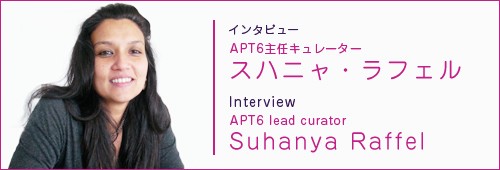
As an art festival focusing in the vast and varied region known as the Asia-Pacific, yet intimately tied to its locale, the Asia Pacific Triennial of Contemporary Art (hereafter APT) is an unparalleled success. We probed the lead curator of APT6 and member of the APT curatorial team since 1999 about the characteristics of this edition and the ideas upon which the APT is formed. What are the keys to success of an international art exhibition in a non-Western region?
Interview: ART iT
– Reading your text in the catalogue and seeing the show I’m impressed with the broadness of view. Tell me about the thematic focus of this exhibition?
We never set out to make an exhibition that explores any one theme. The title Asia-Pacific Triennial of Contemporary Art in itself gives us the structure; a structure that includes history, geography and the question what is contemporary art? That said, there are themes that emerge after we select the artists we think are making the most wonderful work and look at what went on over the past three years that we start to shape the exhibition by.
APT6’s five themes
– What were the themes you identified that shaped the exhibition this time?
There were five. The first is collaboration: in terms of both the APT curators collaborating together and with our external co-curators, and artists collaborating with other artists and with architects, musicians, and all kinds of creative minds. Collaboration seems more prevalent than before, which makes me think that in an increasingly globalized world with quick access to information, creative people are seeking out their own communities, and finding ways of working together.
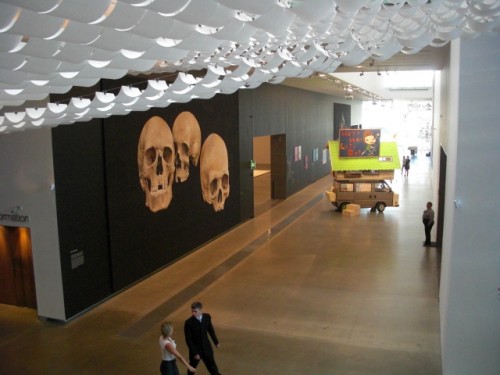
Wit Pimkanchanapong Cloud (ceiling), Shirana Shahbazi Still Lifes (left),
YNG Y.N.G.M.S. (Y.N.G.’s Mobile Studio) (right)
The second is architecture: how artists are responding to and intervening with the physical space – like Wit Pimkanchanapong’s Cloud, or Shirana Shahbazi’s big black wall with the Still Lifes, or Isabel & Alfredo Aquilizan’s In-flight with the airplanes – as well as artists creating architectural forms. There is a utopian idea in some of those architectural forms, from the artist’s studio – Shooshie Sulaiman, Nara Yoshitomo + graf, – through to Ayaz Jokhio with the mihrab forms in the Watermall; DAMP, an anarchic interest with that wonderful column; and then Chen Qiulin with her Xinsheng Town salvaging and putting in the museum a piece of architecture. I’m interested in why this is happening.
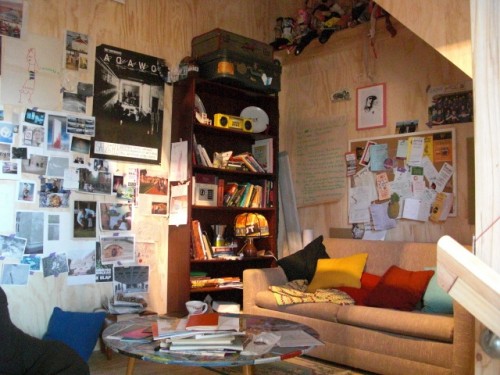
DAMP Untitled
The third theme is sustainability: YNG (Yoshitomo Nara graf) salvaging and reusing; Wit, using very everyday office work, paper, clips – arte povera in a sense, humble materials; Subodh with his big mushroom cloud of used everyday vessels and so on.
The fourth and the fifth are urbanism and modernity. You see these in the room upstairs with Yang Shaobin’s work, bookended by two very different works: the Vanuatu sculptures from Ambrym Island and Chen Qiulin’s Xinsheng Town. Neither of these works, or rather objects, were intended for art museums. They existed quite independently at first – one including a group of houses that people lived in, and the Ambrym sculptures as part of Vanuatu custom. But the artists wanted to bring them into the art museum for reasons related to modernity and urbanization: loss, remembrance – making the museum a place of refuge, where you can remember what is gained as well as what has been lost. All the works in that particular gallery space resonate in relationship to the ideas that those two works position. For us the Pacific voice is a key structural voice within the APT. Most Pacific Islands are not very large, have relatively small populations, with vulnerable infrastructures, so we need to be attentive to those practices and in how we structure the seeing.
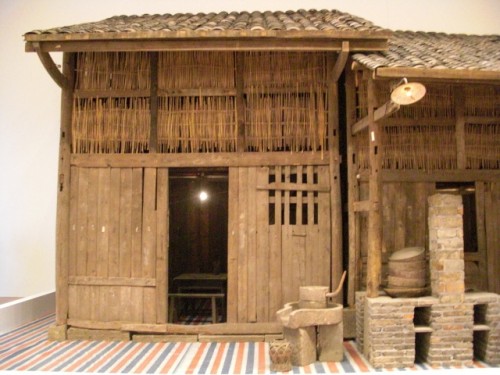
Chen Qiulin Xinsheng Town (detail)
– But some people say that the Pacific arts, especially the traditional arts, are very different from the notion of contemporary art today…
Yes, it’s an important point because it is yet another way in which the APT is both useful and insistent: we respect local art forms made according to local histories; we don’t impose a particular definition of what is contemporary. The definition that you may be talking about comes out of a Westernized, canonical art-historical understanding of what art is. And that’s not always useful when we’re looking over here, because it closes doors, rather than open them.
– This is an important subject that I’d like to talk more about later.
How we structure seeing
– But back to the themes: I thought Tracey Moffatt and Gary Hilberg’s beautiful film Other was a very symbolic piece for this triennial because the title says everything – it speaks both of encounter and conflict with others.
It was a perfect piece for us, interesting because it is also about attraction, desire and love. These are two-way streets that go beyond language. Another work I think is a key is Runa Islam’s A Restless Subject, which considers how illusions are maintained through what is called a ‘persistence of vision’. What are we looking at? What do and don’t we imagine? How we structure seeing. It’s an ideas-driven work that helped me think about the APT.
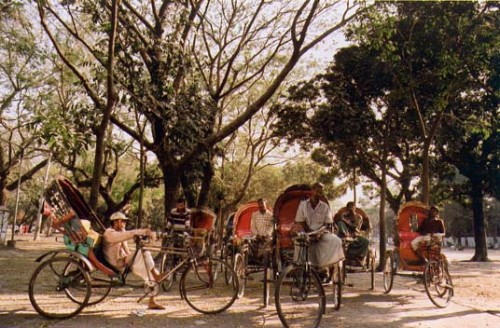
Runa Islam The First Day of Spring
– I think Runa’s other beautiful piece, The First Day of Spring, of the rickshaw drivers in Dhaka is also a very good piece in terms of thinking about the other. What was the reason for including this piece?
Because it is the first work she made when she went back to Bangladesh, which she only did as an adult. She left Bangladesh when she was three to settle in the UK, so she’s a British artist.
Suhanya Raffel
Born in Sri Lanka. Curatorial Manager, Asian & Pacific Art at the Queensland Art Gallery. With degrees in Fine Arts and Museum Studies from the University of Sydney, she has organized numerous exhibitions in the UK, Australia and South Asia. She has been a member of the curatorial team for the Asia Pacific Triennial of Contemporary Art (APT) since 1999, assumed her current post in 2001, and is the lead curator for this year’s APT6. Among her recent curatorial projects for QAG are Andy Warhol (2007-08) and The China Project (2009).
< Back to Index: "The 6th Asia Pacific Triennial of Contemporary Art"
